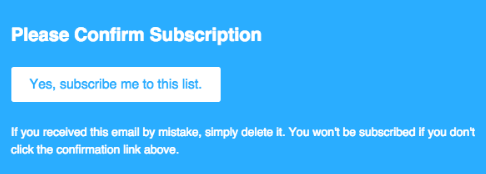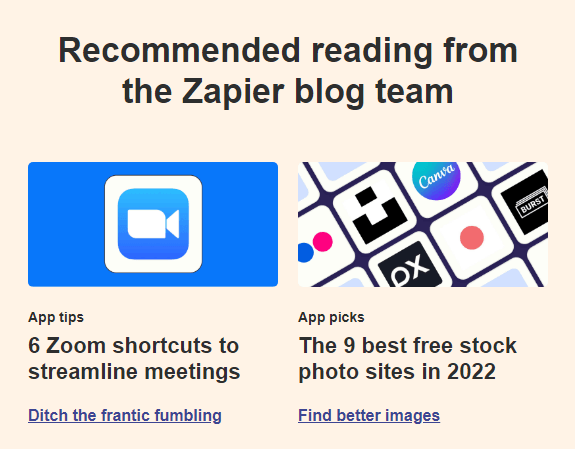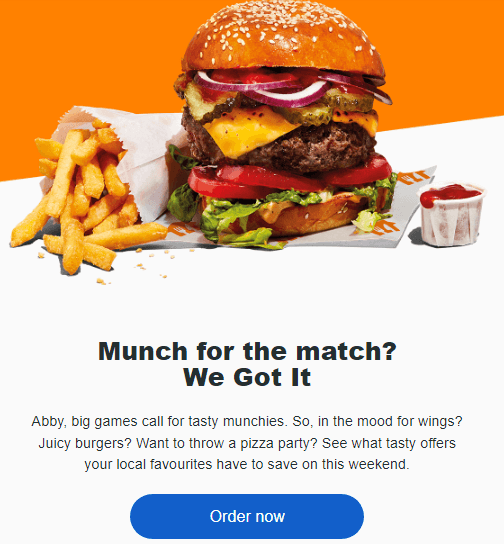- Home
- Blog
- Email Marketing What Is Email Bounce Rate? (+5 Easy Ways to Lower It!)
What Is Email Bounce Rate? (+5 Easy Ways to Lower It!)
-
 Published: Aug 1, 2022
Published: Aug 1, 2022
-
 7 min. read
7 min. read
-
 Abby Fields
Abby Fields Branded Content Specialist
Branded Content Specialist
- Abby is a data-driven content marketer with certifications in inbound marketing and content marketing. She’s written hundreds of articles covering digital marketing topics — a few of her specialties include first-party data, marketing and data analytics, marketing strategy optimization, and SEO. When she isn’t writing or optimizing content, Abby loves to spend time reading the latest mystery novel, having movie marathons with lots of snacks, and jamming out to Shania Twain.
What is email bounce rate? Email bounce rate refers to the number of emails you sent to recipients that could not be successfully delivered to their inboxes.
Email campaigns have the potential to earn you the highest return on investment (ROI) than several marketing strategies. In fact, you can earn $44 for every $1 you spend on email marketing — that’s an impressive 4400% ROI!
But launching an email campaign and hoping it drives results won’t cut it when it comes to achieving those ROI numbers. You must implement multiple techniques and track various metrics to ensure your email marketing campaign boosts your revenue.
Keep reading to learn more about email marketing bounce rates!
And don’t forget to sign up for our newsletter, Revenue Weekly, to get even more revenue-driving email marketing tips sent straight to your inbox for free from our award-winning experts!
Don’t miss our Marketing Manager Insider emails!
Join 200,000 smart marketers and get the month’s hottest marketing news and insights delivered straight to your inbox!
Enter your email below:
Inline Subscription Form – CTA 72
“*” indicates required fields
(Don’t worry, we’ll never share your information!)

What is email bounce rate?
Email bounce rate refers to the number of emails you sent to recipients that could not be successfully delivered to their inboxes. Email providers and anti-spam networks monitor your bounce rate for each campaign you send and use it to determine if they will accept emails from your company in the future.
What does it mean when an email has bounced?
Basically, a bounced email is an undelivered email. In other words, you sent an email to one of your subscribers and the email was never received.
Emails can go undelivered for a number of reasons. One of the most common reasons why an email might bounce is because your recipient no longer has that email address or their email account has been inactive for amount of time and has been deleted.
Hard bounces vs. soft bounces: What’s the difference?
If you have a high bounce rate, your email campaigns could go undelivered for many of your subscribers, resulting in lost leads and conversions for your business.
There are two types of email bounces:
Let’s discuss each one in more detail below.
What is a hard bounce?
A hard bounce is an email that bounced back because the email provider did not accept it.
There are several reasons why you might receive a hard bounce, such as:
- Your recipient’s email address is incorrect
- Your subscriber deleted their email address
- The domain you sent your email to doesn’t exist or is incorrect
Sometimes, even a valid email address might bounce back to you. In most cases, this type of hard bounce occurs because your subscriber’s email provider blocked your email from being delivered.
What is a soft bounce?
A soft bounce is an email that has bounced back after the receiver’s email provider accepts it.
You can receive a soft bounce for several reasons, including:
- Your recipient’s inbox was full
- The recipient’s email server is down or offline
- Your email message is too large
While common causes of a soft bounce may be outside your control, you can ensure that your emails are formatted correctly and contain high-quality content to successfully deliver your emails to many recipients.
How to calculate email bounce rate
So, now that you know the answer to the question, “what is email bounce rate,” let’s go over how it’s calculated.
Here’s how to calculate email bounce rate:
Email Bounce Rate = (Number of Bounces / Number of Delivered Emails) X 100
Let’s put this email bounce rate formula into action with an example. Suppose you sent 100 total emails and 10 of them bounced back. In this case, you would have an email bounce rate of 10%.
What is the average email bounce rate?
Now that you know the email bounce rate formula, you might wonder how your bounce rate compares to your competitors and other businesses.
The average email hard bounce rate is .4%, while the average soft bounce rate is .58%. A good rule of thumb is to aim for an email marketing bounce rate of 2% or lower. A higher bounce rate than this could cause providers to believe your emails are spammy and block them as a result.
How to reduce email bounce rate in 5 easy steps
Reducing your email marketing bounce rate is essential to ensure your marketing messages reach your prospects and customers.
Here’s how to reduce email bounce rate in five easy steps:
- Do a “spring clean” of your email list
- Establish permission-based emails
- Send frequently
- Avoid spammy content
- Consistently monitor your bounce rate
1. Do a “spring clean” of your email list
Sending emails to invalid email addresses causes your messages to bounce back to you. People are unlikely to keep the same email address for life — they might switch providers, change jobs, or change their name.
Make a habit of reviewing your email lists frequently to ensure that you have the correct email address for your subscribers.
You should also remove any addresses from inactive subscribers. These inactive recipients could indicate that they don’t currently use their email address or check their inbox. If they delete their email address in the future, your emails will go undelivered, increasing your bounce rate.
2. Establish permission-based emails
The next step for how to reduce your email bounce rate is to establish permission-based email subscriptions. One of the most common reasons for emails bouncing back is incorrect or invalid recipient email addresses.
Permission-based or double-opt-in email subscriptions can help you ensure that your subscribers enter the correct email address when they sign up for your emails.

For example, when a user signs up for your emails, you’ll send them an email with a link asking them to confirm their email address. Once the recipient confirms their email, you’ll know you have their correct address and can rest easy knowing that your emails will be delivered successfully.
3. Send frequently
One of the best ways to prevent email bounces is to send emails frequently. By sending consistent messages, subscribers won’t forget that they opted in for your emails.
You can also send multiple types of emails to keep your messages varied and engaging. For example, you can showcase your blog posts, videos, or new product releases.

As a result, your subscribers, and most importantly, their email providers, will expect to receive emails from your company.
4. Avoid spammy content
Subscribers and email providers don’t like spam. That’s why one of the best ways to reduce email bounces is to avoid creating spammy content.
If your content reads like spam, your recipient’s email providers may block your email outright, causing your email marketing bounce rate to rise.
The best way to avoid spammy content is to create personalized emails tailored to your subscribers’ interests and provide them with the information they need to solve their problems.

Be sure to avoid copying and pasting the same content or including misleading subject lines and headings to encourage users to open your emails.
5. Consistently monitor your bounce rate
You must keep an eye on your email marketing bounce rate to monitor the success of your campaigns.
If you notice a high bounce rate for certain lists or email campaigns, you’ll want to investigate to see what might be the cause, such as invalid email addresses.
You can then take steps to improve your campaign, like removing spammy content, to reduce your bounce rate.
As a result, you’ll have an email marketing campaign that reaches all your subscribers and prospects, so you can enjoy more conversions and revenue.
93% of WebFX customers are extremely satisfied with their digital marketing results.
“Working with WebFX, everything is very organized and strategic. We’re only a year into our partnership, and our expectations have definitely been met.”
View More Client Testimonials

Reduce your email bounce rate with WebFX
Need to reduce your email bounce rate but don’t know how to get started? WebFX can help!
Our email marketing agency has more than 28 years of experience developing email campaigns that reach your current customers and prospects and encourage them to convert.
And rest assured, your campaign is in good hands. In the past five years alone, we’ve helped clients drive more than $6 billion in revenue.
Ready to launch your revenue-driving email campaign? Get started by calling 888-601-5359 or contact us online. We can’t wait to help your business grow!
-
 Abby is a data-driven content marketer with certifications in inbound marketing and content marketing. She’s written hundreds of articles covering digital marketing topics — a few of her specialties include first-party data, marketing and data analytics, marketing strategy optimization, and SEO. When she isn’t writing or optimizing content, Abby loves to spend time reading the latest mystery novel, having movie marathons with lots of snacks, and jamming out to Shania Twain.
Abby is a data-driven content marketer with certifications in inbound marketing and content marketing. She’s written hundreds of articles covering digital marketing topics — a few of her specialties include first-party data, marketing and data analytics, marketing strategy optimization, and SEO. When she isn’t writing or optimizing content, Abby loves to spend time reading the latest mystery novel, having movie marathons with lots of snacks, and jamming out to Shania Twain. -

WebFX is a full-service marketing agency with 1,100+ client reviews and a 4.9-star rating on Clutch! Find out how our expert team and revenue-accelerating tech can drive results for you! Learn more
Try our free Marketing Calculator
Craft a tailored online marketing strategy! Utilize our free Internet marketing calculator for a custom plan based on your location, reach, timeframe, and budget.
Plan Your Marketing Budget

Looking for More?
Get expert ideas, industry updates, case studies, and more straight to your inbox to help you level up and get ahead.
"*" indicates required fields
Try our free Marketing Calculator
Craft a tailored online marketing strategy! Utilize our free Internet marketing calculator for a custom plan based on your location, reach, timeframe, and budget.
Plan Your Marketing Budget





